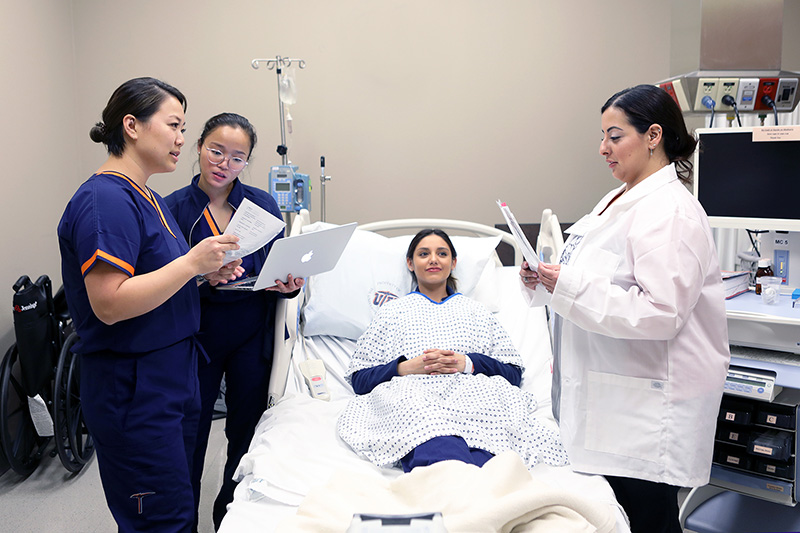
UTEP Simulation Experiences Prepare Nurse Educators
Last Updated on September 02, 2020 at 12:00 AM
Originally published September 02, 2020
By Laura L. Acosta
UTEP Communications
In her role as a nurse educator, Koby Mitchell was responsible for ensuring that the undergraduate nursing students she supervised in the hospital provided safe and effective care.

Mitchell prevented a student from administering the wrong medication to a patient with congestive heart failure. A different student was told to wear gloves before inserting a Foley catheter. Another one was sent home after showing up unprepared.
“It’s important how as an instructor you approach the situation with a student, especially when they think they’ve done a great job, or they’re trying to do a great job, but they just can’t seem to get it right,” said Mitchell, a nursing education graduate student at The University of Texas at El Paso.
“We don’t want to diminish their morale, so you need to remember to remain neutral even in your facial expressions, especially when you’re in front of a patient,” she added. “That’s why you go over everything before you go to the patient’s bedside, because you want to identify any gaps or any knowledge deficits that the student may have.”
Unique Simulation Experience
Although the undergraduate and graduate nursing students were real, the scenarios they participated in were not.
The students were from UTEP’s Bachelor of Science in Nursing (BSN) and Master of Science in Nursing (MSN) programs. They were part of a unique teaching simulation experience developed by the UTEP School of Nursing to prepare aspiring nursing educators to teach in the real world.
Since 2004, more than 300 nurse educators have earned an MSN degree in Nursing Education at UTEP. Mitchell is one of 15 graduates who expected to graduate from the program this August.
The Texas Department of State Health Services predicts that Texas will have a shortfall of 59,970 registered nurses by 2030.
The nursing shortage has led to a growing demand for nurse educators who can share their valuable knowledge and clinical background to prepare new generations of registered nurses.
“We’re using simulation to better prepare our graduate students to practice as educators,” said Jennifer Hull, a part-time UTEP clinical instructor and a 2016 Nursing Education graduate. The scenarios she developed on medication administration, Foley catheter insertion and proper documentation gave future educators such as Mitchell a taste of what it is like to be a teacher.
“Hopefully these scenarios will give them a better insight into the nurse educator role before they’re hired,” Hull said. “They may not always encounter these scenarios with students, but this preparation can help them navigate through difficult situations.”
Hands-on Teaching
Simulation-based teaching is a feature that sets UTEP’s Nursing Education program, which is offered online, apart from the region’s other similar programs. Students come to campus for two days before their final semester to participate in hands-on teaching activities in UTEP’s Center for Simulation, or “sim lab.” Simulation exercises will be offered online during the fall 2020 semester.
According to Diane Monsivais, Ph.D., professor and associate dean of graduate programs at UTEP’s School of Nursing, most simulation experiences prepare students for direct patient care, but hardly any exist for nurse educators.
“”We recognize that just because you’re a good clinical nurse doesn’t mean that you’re automatically a good clinical instructor,” said Monsivais, who previously served as the program’s director. In 2019, she launched the school’s Clinical Faculty Academy to help strengthen the role of clinical nurse educators. “Like everything else, teaching is a skill that you learn. The more you do it, the better you get at it.”
The Simulation Experience
Unlike traditional education programs, student teaching is not part of most nursing education curriculums. Because of this, future nursing instructors are unable to practice and refine their teaching skills with real students before they graduate.
However, the 15 nursing education graduate students who participated in teaching simulations in UTEP’s sim lab on March 5, 2020, experienced what it would be like to interact with undergraduate nursing students in the real world.
Rather than use actors to play the part of students, 16 BSN students followed scripts that directed them to make certain mistakes such as giving the patient the wrong medication. Meanwhile, the would-be nurse educators were tasked with catching and correcting those errors in a manner that would not make the undergraduate students feel awkward in front of the patients.
“In one of the scenarios, we purposely made a medication error that could have potentially harmed the patient,” said BSN major Diego Mendez. “When the graduate student walked in the room, the simulation patient would cough and exhibit symptoms of medication errors, hoping the graduate student would catch on. Some of them caught the error.”
During the simulation, the program’s faculty evaluated each graduate student’s performance and provided feedback on professional issues.
Mitchell, a practicing nurse for 18 years, reviewed teaching materials, including instructional videos on Blackboard, an online learning platform, to prepare for the exercise. She used verbal cues to communicate with BSN students during procedures and asked questions to challenge their critical thinking.
In one instance, Mitchell stood by the patient’s bedside and observed as the student checked the patient’s drug chart for personal information and medication errors.
A red flag immediately went up when Mitchell noticed that the patient’s date of birth did not match the date listed on the chart. The BSN student also insisted on administering a drug that could dangerously lower the patient’s blood pressure. Mitchell used verbal cues to quiz the student about the drug’s side effects. After some probing, the student decided against giving the medication.
“This is as close to reality is as you can get,” said Mitchell, who lauded the preparation that went into the simulation. “I really appreciate that this closely simulated a real clinical experience, and having been bedside, I know what a real clinical experience looks like.”
